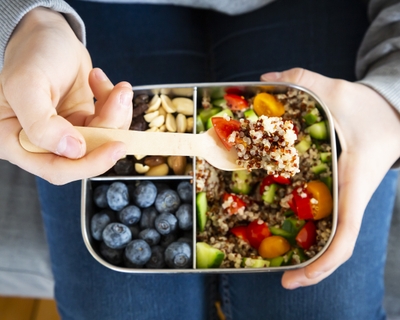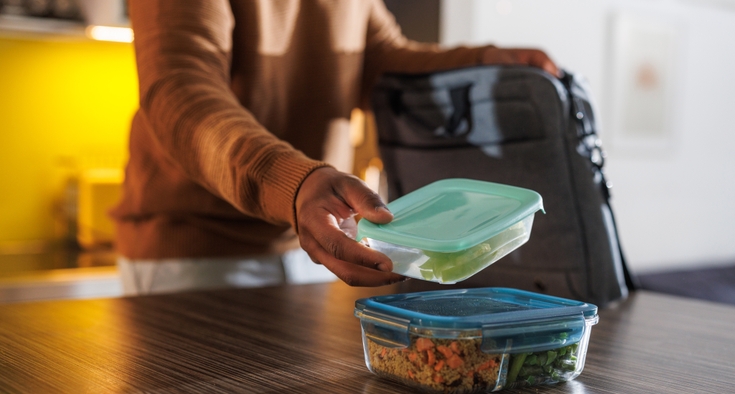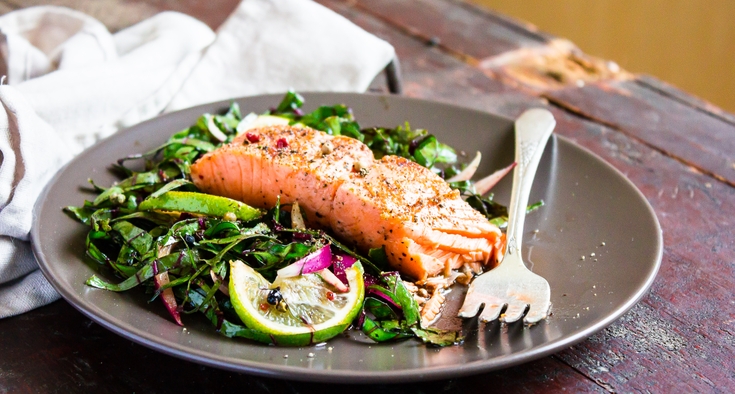For kids, back to school means fresh school clothes, new backpacks and unfamiliar teachers. But for many parents, it also means finding a way to pack lunches that are both kid-approved and nutritious.
Nutrition plays an essential role in helping kids succeed at school. When they’re hungry, children find it difficult to concentrate. But the lunches they often ask for — loaded with added sugars and lacking protein and fiber — can rob them of energy and the ability to focus on the task at hand: learning. What’s a parent to do?

“Instead of worrying about what not to pack in their children’s lunches, I encourage parents to focus on variety and balance,” said Sara Parrish, a wellness dietitian who provides nutrition counseling and wellness programming at the Novant Health Jack Barto Team Member Fitness Center. “That ensures kids get the nutrients they need to succeed at school, while still enjoying some of their favorite ‘fun’ foods.”
Recently, we talked with Parrish — who practices what she preaches when filling her own children’s lunch boxes — about the ins and outs of packing healthy lunches for kids (and adults, too). Keep reading for her favorite tips and a lunch box formula that makes planning simple.
Compassionate health care for your whole family.
Packing the nutrients kids need
The National School Lunch Program has specific guidelines about nutrients (calcium, protein, etc.) and specific foods that public schools must provide each day. Homemade lunches, however, can sometimes fall short of those standards.
“When we pack their lunch boxes, we are responsible for providing our kids with all those important nutrients,” Parrish said. “That’s why I created the lunch box formula handout — to help parents make sure they’re hitting those important areas.”
The lunch box formula includes:
- A good source of protein, such as turkey, cheese or Greek yogurt — supports support growth and immune health.
- A serving of whole grain, like bread, crackers, popcorn, etc. — provides fiber, vitamins and minerals.
- A healthy fat — think: nuts and seeds, hummus or guacamole — fuels kids’ bodies and brains while helping them feel satisfied.
- A “fun” side, such as yogurt raisins, granola bars, mini-muffins, etc. — nutritious and delicious!
- One fruit and one veggie — grapes, berries, sugar snap peas, salad — for fiber, vitamins, minerals and other beneficial plant nutrients.
Best doctors. Amazing nurses. Remarkable care.
Focus on variety
“I encourage parents to include a variety of different colored produce from week to week,” she said. “For example, this week I bought strawberries, cantaloupe and cucumbers for my kids’ lunches, and next week I might switch it up and do grapes, apples and baby carrots.”
And because kids need calcium, she also recommends providing dairy milk (or a calcium-fortified alternative), low-fat cheese or yogurt.
“We want to make sure we are not relying heavily on packaged snack foods or too many sources of added sugars,” she said. “And I do think it’s best to stick with water, milk or 100% juice, instead of packing beverages with added sugar.”
Sara’s favorite tips for creating lunches your kids — and you — will love
Check the list.
Checklists are an ideal way to streamline decision-making and help people feel empowered to plan their own meals. In fact, they work so well that Parrish forgoes strict meal plans and exact recipes for checklists — like the formula below — when working with clients.
“Plus, using checklists to help kids make decisions when packing their lunches turns the process into a learning opportunity,” she said. “In the long run, it’s a much more sustainable approach than telling them exactly what they’re allowed to eat.”
Stock up on a variety of containers.
Small plastic tubs or reusable silicons ‘baggies’ are perfect for storing snacks like pretzels or crackers. You can also find flat containers with snap-on lids that are just right for keeping sandwiches from being smashed by heavier items. And, if your kids enjoy soups, stews or delicious dinner leftovers, you’ll be glad to have large-mouthed thermos jars on hand.
Help kids pack their own lunches.
Once they're old enough to have some decision-making power, children are far more likely to eat the foods that are packed if they’ve had some say in the process, Parrish said. This can be particularly helpful when dealing with a choosy eater.
“At my house, we keep packaged snacks like crackers and pretzels in a basket. The kids get to choose one thing from that basket to go in their lunch box each day,” she said. “They also get to choose the type of fruit they want in their lunch, depending on what we have in the house.”
Embrace packaged fruits.
“Despite the negative press about processed foods, produce doesn’t always have to be fresh,” Parrish said. “Many people are afraid to include fruit cups, applesauce pouches and dried fruits, but these can be great sources of vitamins, minerals, fiber — all the stuff that's good about fruit.”
And there’s a bonus: Packaged fruits are often more cost-effective. They’re shelf-stable, so you can buy them in bulk. And they hold up well in lunch boxes, too.
Make your own Lunchables.
Kids of all ages enjoy this popular lunch product, so why not save money and have more nutritional control by building your own Lunchables at home. You can even buy lunch containers that resemble bento boxes to keep the ingredients separate.
This is a great opportunity to get creative about ingredients. For more fiber, opt for whole-grain crackers. Choose lean meats and low-fat cheese, and add grapes or another favorite fruit — lacking in the store-bought versions — for even more nutrients.
Tempt picky eaters with new foods.
Children are often influenced by their friends. So if another child expresses interest in a food your child is unsure about, that could help motivate them to try it.
“Of course, packing a whole lunch of everything your kids dislike is not a good idea,” Parrish said. “But you might include a little bit of something they’re less comfortable with in a lunch box full of foods they really love.”
Take a field trip – to the grocery store.
Show your kids the lunch box formula handout and talk with them about the kinds of foods that make up a healthy lunch. When you go to the store together, ask them to point out some items — fruits, vegetables, snacks — they would like to add. If they ask for something you’re not comfortable with, try to offer a reasonable alternative they’ll still enjoy.
Add an element of surprise!
Lunch boxes provide a wonderful opportunity to get creative and add a dose of delight to your child’s — or anyone else’s — day. Short on time? No worries! These ideas are perfect for those mornings when you have a few extra moments:
- Hide a quick sketch or encouraging note in the lunchbox.
- Cut fruit slices or sandwiches into fun shapes with cookie cutters.
- Make sandwich rolls with tortillas or flatbread and cut them into “pinwheel” slices.
- Tuck in a hand-made coupon for a special activity — a trip to the park or their favorite frozen yogurt shop — you can enjoy together after school.

Sara’s easy lunch box formula
Making lunch is easy when you have this checklist on hand. Just follow the formula below, and have fun mixing and matching foods from the different categories. Here are some sample lunches to help you get started:
Sample Lunch #1
- Turkey sandwich on a whole grain bagel (one protein and one whole grain)
- Individual hummus cup with carrot sticks (one healthy fat and one veggie)
- Seedless red grapes (one fruit)
- Granola bar (one “fun” snack)
Sample Lunch #2
- Plain Greek yogurt drizzled with honey and sprinkled with granola (one protein and one whole grain)
- Homemade “trail mix” with almonds and yogurt raisins (one healthy fat and one fruit)
- Raw sugar snap peas (one veggie)
- Graham crackers (one fun snack)
Lunchbox formula
| 1 protein | 1 whole grain | 1 healthy fat |
|
|
|
| 1 fruit | 1 veggie | 1 "fun" side |
|
|
|










